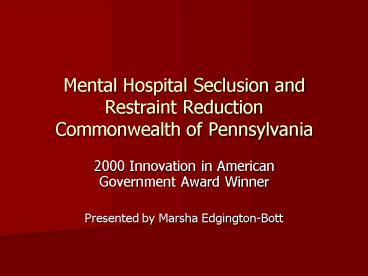Mental Hospital Seclusion and Restraint Reduction Commonwealth of Pennsylvania - PowerPoint PPT Presentation
1 / 15
Title:
Mental Hospital Seclusion and Restraint Reduction Commonwealth of Pennsylvania
Description:
Mental Hospital Seclusion and Restraint Reduction. Commonwealth of Pennsylvania ... Rate/1000 patient days. Restraint. Changes that Influenced S/R Reduction ... – PowerPoint PPT presentation
Number of Views:270
Avg rating:3.0/5.0
Title: Mental Hospital Seclusion and Restraint Reduction Commonwealth of Pennsylvania
1
Mental Hospital Seclusion and Restraint
ReductionCommonwealth of Pennsylvania
- 2000 Innovation in American Government Award
Winner - Presented by Marsha Edgington-Bott
2
Background
- In the late 1980s national attention was
beginning to be focused on practiced use and
risks associated with the use of seclusion and
restraint with adults, children, and adolescents
in mental health programs and facilities. - Risks include accidental death, injuries and
emotional harm to both staff and patient,
continual disruption of the therapeutic
relationship with the patient and families and
exposing them to further trauma.
3
Pennsylvania-A Model for Reform
- In 1997 the Pennsylvania Department of Public
Welfare instituted an aggressive program to
reduce and ultimately eliminate seclusion and
restraint use in its nine state hospitals. - They began the reform in 1990 by carefully
tracking the use of Seclusion/Restraint (S/R) and
then used the 1997 data as its baseline to
measure improvements.
4
Year 2000
- By 2000, Pennsylvania had reduced incidents of
seclusion and restraint in its nine state
hospitals by 74, and reduced the number of hours
patients spent in seclusion and restraint by 96. - By July of 2000, one state mental hospital had
not used seclusion for over 20 months. - Another had used neither seclusion or restraint
for 8 of the last 12 months. - Three hospitals had been S/R free for one or more
consecutive months and others were approaching
zero use.
5
Prevalence and duration of seclusion and restraint
6
Changes that Influenced S/R Reduction
- Leadership the non-restraint movement within
the Pennsylvania state hospital system predates
the period covered by the study. The most
dramatic reductions occurred from 1993 to 1997. - The greatest credit goes to the direct care
staff, aides, nurses, doctors and program staff.
7
Changes continued
- Advocacy - organized advocacy efforts led by
parents and former patients who represented the
National Alliance for the Mentally Ill, the
Pennsylvania Mental Health Consumers Association,
and the Pennsylvania Protection and Advocacy,
Inc. were effective at addressing individual
patient issues and challenging leadership.
8
Changes continued
- State Policy changes state policy on the use of
restrictive procedures changed three times during
the study period. - Defined physical restraint, mechanical restraint,
and seclusion as extreme measures and limited
their use to emergency situations. - Defined Chemical restraint.
- Established guidelines for annual staff training
and patient/staff debriefing. - Required notification of a persons family after
the use of restrictive measure. - Limited orders for restraint and seclusion to no
more than 60 minutes requiring the person be
seen within 30 minutes of a phone order. - Required monitoring of policies through
performance improvement program. - Limited the types of restraint that could be
used.
9
Changes continued
- Psychiatric emergency response teams (PERTs)
brings together a large group of workers to the
scene of the crisis in a short period. - The goal is to manage a crisis using conflict
resolution, mediation, therapeutic communication,
and violence-prevention skills to diffuse and
safely resolve a crisis. - PERTs involves a core group of staff which are
required to upgrade the quality and quantity of
crisis management and verbal de-escalation
techniques at least annually.
10
Changes continued
- Unit size and patient-to-staff ratios having
fewer patients on a unit allows more sensitive
care and a safer, restraint-free hospital. - The average number of people served on a typical
hospital unit during the study period decreased
from more than 36 in 1990 to 32 or less in 2000. - In 1990-the 36 patients had one licensed nurse
and three psychiatric aides. - During 2000-the 32 patients had two licensed
nurses and four psychiatric aides.
11
Changes continued
- Incident management system July 1998 a new
application was implemented statewide that
increased the performance indicators which would
be reported. - The system enables measurement of physical
hands-on restraint to the second and mechanical
restraint use by device type. - Tracks the PRN and STAT medications administered.
- Data is summarized each month and shared with the
hospital system and external advocates.
12
Changes continued
- Second generation antipsychotics
- Increase in the quantity and quality of treatment
- focusing on functional programming such as
vocational services, paid work, money management
skills, and training in the self-administration
of medications. - Increases in the quantity and quality of
therapies due to reduced unit sizes and improved
patient-to-staff ratios.
13
Most Important Changes
- Changes in the culture of the state hospitals.
- Pennsylvania required open public access to S/R
data. - Creating competition among the hospitals to
reduce S/R. - Giving awards and acknowledgments for
improvements.
14
Where are they now?
- Currently five of the nine hospitals have
eliminated the use of seclusion. - Danville State Hospital has gone more than two
years without using mechanical restraint or
seclusion. - Since January 2005, the hospital system, which
averages more than 60,000 days of care each
month, has used seclusion only 19 times for a
total of 18 hours. - Mechanical restraint has been used 143 times for
a total of 160 hours. - During December 2005, in the nine hospital system
S/R was used 8 times for a total of 8.67 hours
and seclusion was used only 2 times for a total
of 1.08 hours.
15
Where are they going?
- In the Spring of 2005, the hospital system
established a goal eliminating the use of
mechanical restraint and seclusion by January 1,
2006. - They havent met the goal at this time, but they
are committed to achievement.

